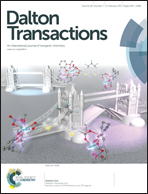Modulation of electronic and redox properties in phenolate-rich cobalt(iii) complexes and their implications for catalytic proton reduction†
Abstract
We investigate the redox, spectroscopy and catalytic reactivity of new cobalt(III) complexes based on phenolate-rich [N2O3] ligands. These complexes are described as [CoIII(LX)MeOH], where X indicates the presence of chloro (1), bromo (2), iodo (3), or tert-butyl (4) substituents in the 3rd and 5th positions of each phenolate ring. These substituents modulate the Co(III) ← PheO− LMCT bands of the parent complexes with 1 (451) > 2 (453) > 3 (456) > 4 (468 nm) and the redox potentials involved with the Co(III)/Co(II) and ligand reduction and with the phenolate/phenoxyl oxidation processes. The influence of the substituents on the phenolate pendant arms was also observed on the kinetic parameters; 1 presented a rate constant of 1.0 × 10−3 s−1 whereas 4 showed a considerably slower rate (5.3 × 10−5 s−1). Species 1 and 4 are electrocatalysts towards proton reduction in the presence of weak acid in acetonitrile. A TON of 10.8 was observed for 1 after 3 h of bulk electrolysis at −2.20 VFc/Fc+ using a mercury pool as the working electrode.


 Please wait while we load your content...
Please wait while we load your content...